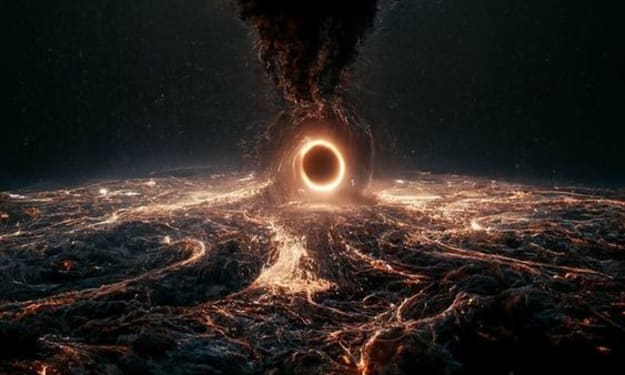Gravitational Waves!!!
Gravitational Waves: Ripples in the Fabric of Spacetime

Gravitational Waves: Ripples in the Fabric of Spacetime
In the grand theater of the cosmos, where celestial bodies dance to the tune of gravity, there exists a phenomenon so profound that it reverberates through the very fabric of spacetime itself. This phenomenon is known as gravitational waves—ripples in the cosmic ocean—whose discovery in the 21st century transformed our understanding of the universe and offered a new way to explore the cosmos.
The story of gravitational waves begins with a brilliant insight by none other than Albert Einstein. In 1915, Einstein, armed with his theory of general relativity, predicted the existence of gravitational waves. He proposed that massive objects, like planets and stars, could warp spacetime around them as they moved through the cosmos, causing ripples—gravitational waves—that would propagate outward at the speed of light.
For decades, gravitational waves remained a theoretical concept, tantalizing but unproven. The search for these cosmic ripples was fraught with challenges because their effects were minuscule, requiring extraordinarily sensitive instruments to detect.
It wasn't until the turn of the 21st century that the hunt for gravitational waves gained momentum. In 2015, the Laser Interferometer Gravitational-Wave Observatory (LIGO) made history by detecting gravitational waves for the first time. The waves had been generated by the collision of two massive black holes more than a billion years ago, and their detection was a testament to human ingenuity and perseverance.
The discovery of gravitational waves opened a new era of astronomy—the era of "multi-messenger" astronomy. For the first time, scientists could observe the universe not only through electromagnetic waves (such as light and radio waves) but also through gravitational waves. This breakthrough allowed astronomers to explore cosmic phenomena that had been invisible to traditional telescopes.
Gravitational waves have since revealed a wealth of cosmic phenomena, from the collision and merger of black holes and neutron stars to the oscillations of cosmic strings, hypothetical cosmic structures. Each detection has provided a unique glimpse into the most extreme and energetic events in the universe.
One of the most groundbreaking moments in the study of gravitational waves came with the detection of the first neutron star merger in 2017. This event, observed by both LIGO and the Virgo interferometer, not only produced gravitational waves but also a burst of electromagnetic radiation, including gamma-ray bursts. It marked the first time a cosmic event had been observed through multiple messengers, confirming the profound synergy between gravitational wave and traditional astronomy.
Gravitational waves have also allowed scientists to test Einstein's theory of general relativity with unprecedented precision. Every detection provides a new opportunity to explore the nature of gravity itself, to examine the properties of black holes and neutron stars, and to delve into the heart of cosmic mysteries.
As we continue to detect and study gravitational waves, we stand on the precipice of transformative discoveries. The cosmos has become an orchestra, and gravitational waves are the cosmic symphony—a symphony that tells the story of the universe's most dramatic and energetic events.
The story of gravitational waves is a testament to human curiosity and the indomitable spirit of exploration. It reminds us that the universe is not silent but filled with the vibrations of spacetime itself. Gravitational waves beckon us to venture further into the cosmos, to listen to the cosmic symphony, and to uncover the secrets of the universe hidden in the ripples of spacetime.
In the endless expanse of the universe, where mysteries abound and the cosmos unfolds its grand narrative, we find ourselves at the threshold of profound discoveries. From the quest to unearth distant exoplanets and unravel the enigmas of black holes, dark matter, and dark energy to the detection of gravitational waves that resonate through spacetime, our journey through the cosmos is an odyssey of curiosity and wonder.
As we venture deeper into the cosmos, we are confronted with the boundless mysteries that beckon us to explore, to question, and to seek answers to the most profound questions of existence. The universe is not a silent void but a vibrant tapestry of cosmic wonders, each discovery a testament to human ingenuity and our relentless pursuit of knowledge.
In our quest to understand the universe, we are reminded that the cosmos is a story waiting to be told—a story of cosmic symphonies, cosmic shadows, and cosmic ripples. These discoveries offer a glimpse into the essence of our existence, challenging our perceptions and expanding our horizons.
As we peer into the cosmic unknown, we are inspired to continue our journey, to unravel the mysteries that lie at the heart of the universe, and to embrace the awe-inspiring beauty and complexity of the cosmos. The cosmos is our canvas, and the discoveries within it are the strokes of inspiration that color our understanding of the universe and our place within it.
So, let us continue our exploration, for the universe is an ever-unfolding narrative, a story waiting to be told, and a cosmos waiting to be discovered.
About the Creator
Raymark Marcos
A Writer and Guitarist
A son of God
A student who's doing a lot of side hustles to earn enough money to be able to go for college.






Comments
There are no comments for this story
Be the first to respond and start the conversation.